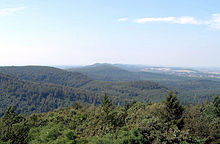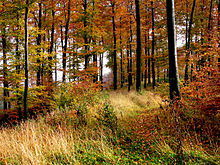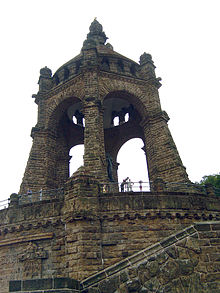- Teutoburg Forest
-
The Teutoburg Forest (German: Teutoburger Wald) is a range of low, forested mountains in the German states of Lower Saxony and North Rhine-Westphalia which used to be believed to be the scene of a decisive battle in AD 9.[1] Until the 19th century the official name of the mountain ridge was Osning.
Contents
Geography
The Teutoburger Wald is a far northern extension of the central European uplands, extending east toward the Weser river, south from the town of Osnabrück and southeast to Paderborn. A broad valley, the site of the city of Bielefeld, divides it into the two portions called Northern Teutoburg Forest and Southern Teutoburg Forest. Except for a short area south of Osnabrück, which belongs to the Bundesland of Lower-Saxony, the whole forest is part of North Rhine-Westphalia.
The highest elevation in the Southern Teutoburg Forest is the Velmerstot (468 m) (south of Horn-Bad Meinberg). In the Northern Teutoburg Forest the highest elevation is the Dörenberg (331 m) (north of Bad Iburg).
The river Ems has its source in the southernmost portion of the Teutoburg Forest.[2]
The geologically oldest is the northern ridge, which consists of limestone of the Triassic.
History
The forest was believed[by whom?] to have been the site of a battle between the Roman Empire and an alliance of Germanic tribes in AD 9. The Roman historian Gaius Cornelius Tacitus identified the location of the battle as saltus Teutoburgiensis (saltus meaning a forest valley in Latin), and the encounter was therefore called the Battle of the Teutoburg Forest. However, recent excavations suggest that at least the final stages of the battle took place farther northwest, at Kalkriese, north of Osnabrück.[3]
As of 2011[update] the Teutoburg Forest comprises two separate National Parks:
- TERRA.vita Nature Park, northwest part between Bielefeld and Osnabrück
- Teutoburg Forest / Eggegebirge Nature Park between Bielefeld and Diemeltal
Hills
Main article: List of hills in the Teutoburg ForestHermann's Memorial and renaming of the Osning
Arminius (a.k.a. Hermann the Cherusker), leader of the Germanic tribes during the battle, became something of a legend for his overwhelming victory over the Romans. During the period of national renaissance in the wake of the Napoleonic wars, he was seen as an early protagonist of German resistance to foreign rule and a symbol of national unity. A monumental statue of Arminius commemorating the battle, known as the Hermannsdenkmal (the "Hermann monument"), was erected on the Grotenburg hill near Detmold, near the site where the most popular theory of the time placed the battle. The monument was dedicated in 1875 by Emperor Wilhelm I, first Kaiser of the unified German Empire. He got his own monumental statue at the north of the Osning, called Porta Westfalica, set up at the hill Wittekindsberge in the mountain range of the Wiehen Hills. In order to create a national landscape the Osning mountains came to be named today as the "Teutoburg Forest", see also Teutonic. However, the old name survived among the local population. Over the years, it has become a local tradition to kiss the lowest part of the memorial for good luck.
It is also the forest in which the composer Johannes Brahms liked to walk during his stay in Detmold.
Websites
References
- ^ Paul K. Davis, 100 Decisive Battles from Ancient Times to the Present: The World’s Major Battles and How They Shaped History (Oxford: Oxford University Press, 1999), 68.
- ^ Teutoburg Forest at Destination Germany
- ^ http://rambambashi.wordpress.com/2010/05/22/common-errors-32-teutoburg-forest/
Coordinates: 51°53′44″N 8°48′49″E / 51.89556°N 8.81361°E
Arnsberg Forest | Bavarian Forest | Black Forest | Bohemian Forest | Ebbegebirge | Eggegebirge | Eifel | Elbe Sandstone Mountains | Elstergebirge | Fichtelgebirge | Franconian Jura | Franconian Forest | Gladenbach Uplands | Habichtswald | Harz | Hoher Meißner | Hunsrück | Kaiserstuhl | Kellerwald | Kaufungen Forest | Knüll | Kyffhäuser | Lusatian Mountains | Lennegebirge | Lippe Uplands | North Palatine Uplands | Odenwald | Ore Mountains | Palatine Forest | Rhön | Rothaargebirge | Saalhausen Hills | Swabian Jura | Siebengebirge | Solling | Spessart | Taunus | Teutoburg Forest | Thuringian Highland | Thuringian Forest | Upper Palatine Forest | Vogelsberg | Weser Uplands | Wesergebirge | Westerwald | Wiehen Hills | Zittau Hills
 Categories:
Categories:- Forests and woodlands of Germany
- Mountains and hills of North Rhine-Westphalia
- Forests and woodlands of Lower Saxony
- Teutoburg Forest
Wikimedia Foundation. 2010.





